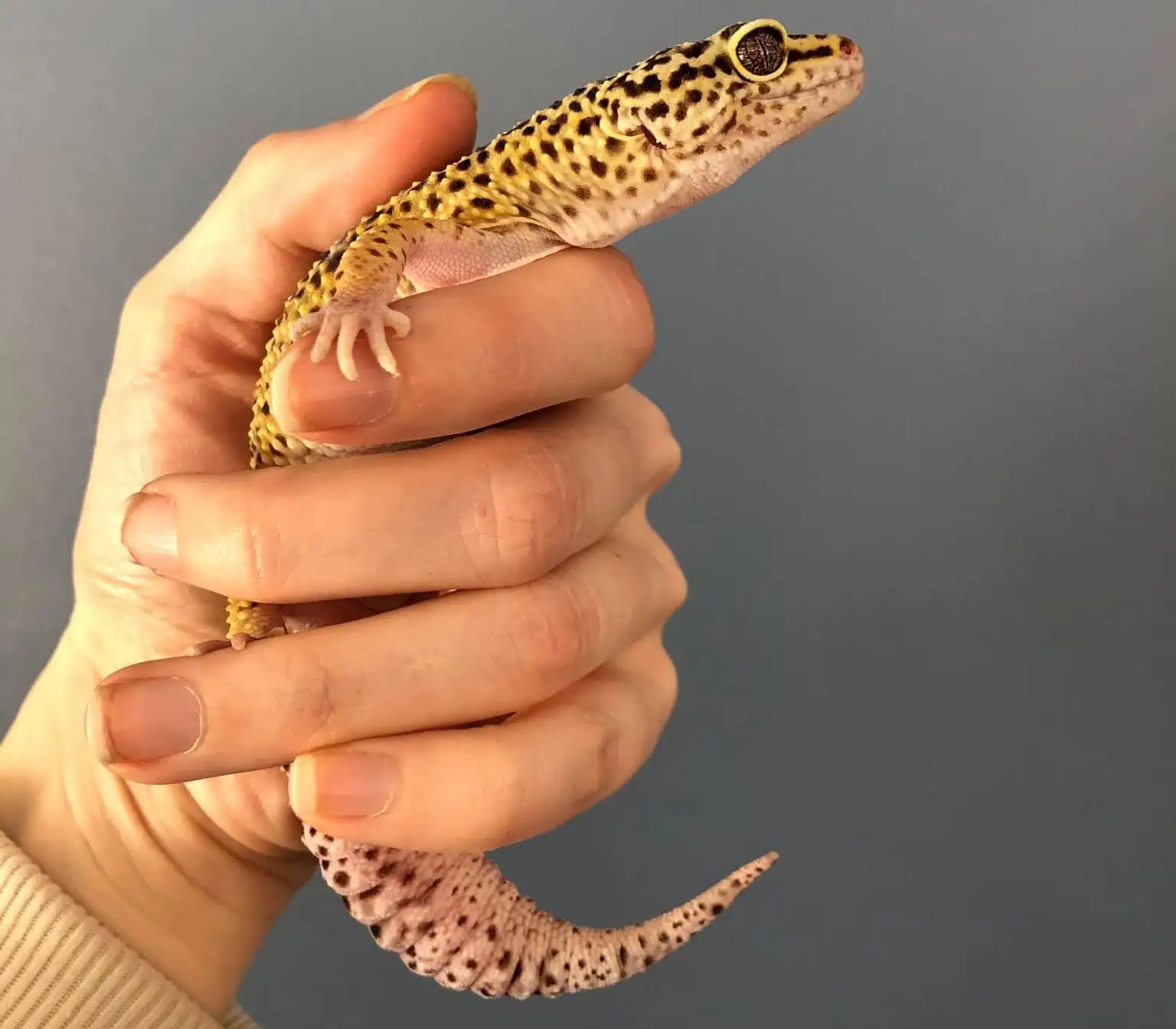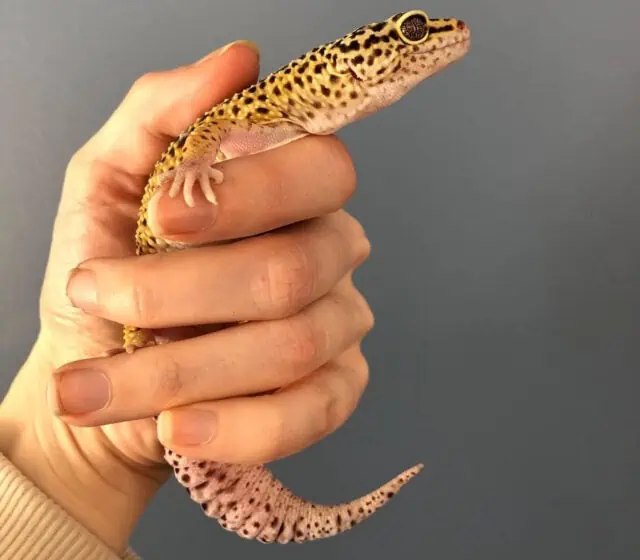Leopard Geckos may squeak because they have a varied range of emotions and needs they are trying to express. This engaging reptile, renowned for its vibrant patterns and nocturnal lifestyle, uses squeaking to communicate with fellow geckos and humans, alerting them to a myriad of possible feelings or necessities.
They might be conveying messages of discomfort, excitement, or simply attempting to interact. These sounds may stem from feelings of threat or fear, pain, or discomfort, due to hunger or while feeding, or even as a manifestation of respiratory issues.
Communication: Leopard geckos use squeaking as a primary means of communication, conveying feelings, intentions, and messages to fellow geckos and their owners.
Signs of Distress: Squeaking can indicate discomfort, pain, or feeling threatened. Keep an eye on triggers like sudden movements or a noisy environment and adjust accordingly.
Health Concerns: Respiratory issues in leopard geckos might manifest as clicking noises, wheezing, or labored breathing. Prompt veterinary care is crucial.
Mating Calls: During mating season, leopard geckos exhibit distinct vocalizations and behaviors as part of their courtship rituals.
Dietary Needs: Ensure leopard geckos are provided with a proper diet. Excessive squeaking can sometimes indicate hunger or the need for feeding adjustments.
7 Reasons Why Leopard Geckos May Squeak
Understanding why leopard geckos squeak can give us a glimpse into their lives. Squeaking, in essence, serves as a multifunctional tool allowing these intriguing creatures to express their needs, emotions, and responses to their environment.
As A Way To Communicate
Leopard geckos employ squeaking as a vital form of communication, a unique language allowing them to interact with their environment, other geckos, and even their owners. Through these vocalizations, they share invaluable information about their feelings, needs, and experiences.
In various scenarios, these little reptiles may utilize squeaking to convey messages, each with its own unique meaning. For instance, when interacting with other geckos, a squeak could be a sign of greeting, or, at times, it could be a warning or a call signaling discomfort. When communicating with their owners, squeaks might be their way of expressing needs or alerting to their current emotional state.
Deciphering the meanings behind different squeaking sounds and behaviors is like learning a new dialect. A rapid series of squeaks may signify excitement or urgency, while isolated, infrequent squeaks might indicate contentment or a casual acknowledgment.
They Feel Threatened
Leopard geckos, like many animals, have inherent instincts to protect themselves from perceived threats. When they feel threatened, they exhibit distinct behaviors and body languages, communicating their sense of danger or fear to the outside world.
Various scenarios can make leopard geckos feel uneasy. An abrupt change in their environment, the presence of predators, or even unfamiliar sounds and movements can trigger a fear response. In these situations, squeaking serves as an alarm, a vocal expression of their heightened stress levels.
Observing their body language and behavior closely can reveal signs of fear or discomfort. A leopard gecko might exhibit rapid, erratic movements, try to hide, or may arch their back as a defensive posture. These physical responses are coupled with squeaking to accentuate their feeling of threat, signaling their need for safety and comfort.
They’re In Pain or Feel Discomfort
Leopard geckos, when in pain or experiencing discomfort, may emit squeaks as audible indicators of their distress. This vocalization can act as a distress signal, drawing attention to their suffering and serving as a vital clue to underlying issues that require attention.
Several circumstances can lead to pain or discomfort in leopard geckos, prompting them to vocalize their distress through squeaking. Injury is a common cause, where any physical harm or trauma can lead to noticeable discomfort.
Illness is another significant factor, with various ailments causing a range of symptoms, including pain, which can trigger squeaking. Observing such behaviors is crucial, as it can be indicative of a need for immediate care and attention.
For example, a gecko that is frequently hiding, refusing to eat, or displaying a noticeable change in behavior, combined with squeaking, could be signaling pain or discomfort.
In such cases, a detailed examination is essential to identify any injuries, signs of illness, or other abnormalities, allowing for prompt intervention and treatment to alleviate their suffering.
Mating Behavior
Leopard geckos exhibit intriguing mating behaviors, characterized by distinctive sounds and courtship rituals, as they seek to attract a suitable mate. During the mating season, their behaviors become more pronounced, with unique vocalizations and physical displays playing a crucial role in their reproductive dance.
The courtship rituals of leopard geckos are fascinating to observe, with males and females engaging in distinctive behaviors.
Males typically initiate the courtship by approaching females with a distinctive gait, vibrating their tails, and producing soft squeaking sounds, signaling their interest.
Females, in response, may accept or reject the advances, sometimes responding with their own set of vocalizations.
Various vocalizations and physical displays are integral to their mating behavior. These include soft chirping sounds, tail vibrations, and gentle biting, each serving a specific purpose in their courtship dance.
Hungry or Feeding
Leopard geckos can be particularly vocal when they are hungry or during feeding times, utilizing squeaking to communicate their needs or responses to food. Observing their behavior during these times is critical, as it can provide significant insights into their dietary needs and preferences.
Typically, when in need of food, leopard geckos may become more active and alert, exploring their environment in search of prey. They might start squeaking to express their hunger, and this behavior can become especially noticeable when they are being fed.
Their reactions to different food items, indicated by varying squeaks and behaviors, can reveal their preferences, helping in formulating an optimal diet for them.
While Exploring
While exploring their environment, leopard geckos often vocalize, producing squeaks that could be expressions of their excitement, curiosity, or a way to communicate with their surroundings. Exploration is innate to leopard geckos, allowing them to familiarize themselves with their environment and find food, shelter, and mates.
Several reasons can explain why leopard geckos squeak while exploring. This behavior may signify their excitement as they discover new areas or encounter interesting objects. It can also represent their curiosity, as they investigate their surroundings and interact with various elements within their environment.
Respiratory Issues
Leopard geckos experiencing respiratory issues may exhibit symptoms such as wheezing, labored breathing, or distinct clicking noises, requiring prompt attention and care. Identifying and addressing respiratory issues early on is crucial to prevent the condition from worsening and ensuring the well-being of the gecko.
Respiratory issues in leopard geckos may manifest due to various causes, such as respiratory infections, often resulting from unsuitable environments, poor husbandry, or exposure to extreme temperatures and humidity levels.
An unsuitable environment, marked by improper temperature, humidity, and substrate, can compromise their immune system, making them susceptible to respiratory infections.
Recognizing the signs of respiratory distress, such as audible breathing difficulties and abnormal noises, and seeking veterinary care promptly is paramount.
A veterinarian can provide a proper diagnosis and prescribe the appropriate treatment, including medications and modifications to the gecko’s environment, to address the underlying cause and alleviate the symptoms.
What To Do When Your Leopard Gecko is Squeaking
When your leopard gecko is squeaking, identifying the causes and taking appropriate action is crucial to address any underlying issues effectively. By understanding the potential reasons behind the squeaking and responding appropriately, you can ensure the well-being of your pet.
Start by observing the behavior and the environment of the leopard gecko closely. Review if the squeaking is associated with specific situations, such as feeding or exploring, or if it’s accompanied by other signs of distress, like labored breathing or altered body language. Pinpointing the context and accompanying behaviors can help identify the underlying causes and guide the subsequent steps.
For each identified cause, consider the following solutions:
Communication or excitement: No specific action may be required, but observing further can confirm whether the gecko is simply communicating or expressing excitement. Don’t mistake the appearance of a smile with something positive; there is no connection to the way people express themselves.
Feeling threatened or in danger: Ensure the environment is secure and free from potential threats, and avoid sudden movements or loud noises around the gecko.
Pain or discomfort: Inspect the gecko for any signs of injury or illness and consult a veterinarian promptly for diagnosis and treatment.
Mating behavior: Understand the mating behaviors and ensure that any interaction between male and female geckos is monitored to prevent aggression.
Hunger or feeding: Regularly provide a nutritious and well-balanced diet to meet the gecko’s nutritional needs.
Exploration: Ensure the gecko’s environment is enriched and stimulating, offering ample opportunities for exploration and interaction.
Respiratory issues: If signs of respiratory distress are observed, seek immediate veterinary care to address any respiratory conditions or infections effectively.






